![]()
It was a mixed week. Sandwiched in between the hartals and the ekushey
barefoot walks and the launch disaster, were news items that led to very
different emotions at Drik. Shoeb Faruquee, the photographer from Chittagong, won the 2nd prize in the Contemporary Issues, Singles,
category of the world’s premier photojournalism contest World Press
Photo. The photograph of the mental patient locked by the legs as in a
medieval stock, is a haunting image that is sure to shake the viewer.
However, the stark black and white image tells a story that is far from
black and white. In a nation with limited resources, medical care for
all is far from reality. Expensive western treatment is beyond the reach
of most, and has often been shown to be flawed. Alternative forms of
treatment is the choice of many. The fact that the boy photographed was
said to have been healed, further complicates the reading of this image.
Shoeb is one of many majority world photographers who have attempted to
understand the complexities of their cultures, which rarely offer
simplistic readings.
It was later in the week, that Azizur Rahim Peu, told me that the
affable contributor to Drik, Mufty Munir, had died after a short illness
at the Holy Family Hospital. I would contact Mufty when I was in
trouble, needing to send pictures to Time, Newsweek or some other
publication. We would work into the night at the AFP bureau, utilising
the time difference, to ensure the pictures made it to the picture desk
in the morning. Occasionally, while hanging out at the Press Club
waiting for breaking news, we would dash off together. Mufty
uncomfortably perched on the back of my bicycle and me puffing away
trying to get to the scene in time.
Wire photography is about speed, and their photographers are known for
being pushy, but this shy, quiet, self effacing photographer made his
way to the top through the quality of his images. We had to push him to
have his first show in 1995, which our photography coordinator Gilles
Saussier and I curated. The show at the Alliance was a huge success, but
Mufty was not impressed by the excitement the show had created. He
simply wanted to get on with his work.
He did have problems with authority, or rather, authority had problems
with him. Despite his shyness, he was a straight talking photographer,
who didn’t hesitate to protest when things weren’t right. Not being the
subservient minion the gatekeepers of our media are accustomed to, he
often got into trouble. But the clarity of his protests played an
important role in establishing photographers’ rights. In the abrasive
world of press photography, where elbows do much of the talking, this
gentle talented practitioner will be dearly missed.
Unknown to the rest of us, the brother of Rob, the gardener at Drik,
died in the launch that sank in the storm at the weekend.
Category: Photojournalism
Kwaito Culture
Subscribe to ShahidulNews
![]()
Neo’s work is one of the 40 exhibitions to be seen at the coming festival of photography Chobi Mela III. The festival opens on the 6th
December 2004 in Dhaka. 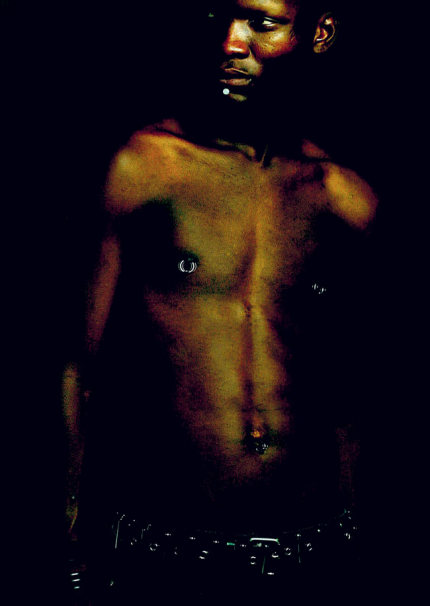
http://www.newint.org/issue371/exposure.htm
This picture is part of my self-initiated project SA Youth ID – Kwaito Culture, a personal and reflective body of work about the changes in the lives of South Africans in the new democratic country. The word Kwaito is derived from the Afrikaans kwaai – ‘angry’. In colloquial slang, negative words or phrases often acquire a positive connotation or ‘cool’ status. The language of Kwaito is Isicamtho, South African township slang.
While working on the project it became clear to me that the youth of South Africa refuse to be condemned by the politics of the past (apartheid) but choose to find their own identity. They have been developing one which is truly and proudly South African – Kwaito culture. It’s about peace, love and unity; about being yourself and loving yourself enough to be YOU.
I am a 31-year-old female photographer. I did my photography studies in Cape Town and Pretoria. I then freelanced in Mmabatho, my hometown, before moving to Johannesburg. My original interest was in film and television. But I could not pursue my dream because of the political situation in South Africa at the time. In 2000 I joined The Star newspaper. I later spent a year teaching at Pathshala South Institute of Photography in Bangladesh.
I have always been inspired to change the gender imbalance in photography. My recent achievement – the first woman CNN Africa Photographer of the Year – has motivated me to devote my time to this even more, popularizing the profession among other wome and ploughing back the knowledge I have gained by making a difference in the lives of others. I continue to work at The Star, specializing in news, fashion and theatre photography.
Neo Ntsoma
South Africa
World Press Photo In Dhaka: Behind The Scenes
![]()
With hundreds of people seeing the show every day, and excellent media
coverage, it might appear as if the staging of WPP photo in Bangladesh was a
smooth well organised affair. As Marc will testify, the reality was very
different. For those of you who have seen the show at the gallery or online,
this behind the scenes look will provide an amusing take on a potential
disaster.
The crates had arrived at Zia International Airport on the 24th of December
2003, but the journey from Zia to Dhanmondi took considerably longer. The
opening was at 4:00 pm on the 7th January 2004. By 3:30 pm, the crates
hadn’t arrived! We did know they had left the airport, and was able to tell
the Dutch Ambassador that it was safe for him to come over. The head of the
caretaker government, our chief guest, Justice Habibur Rahman was already on
his way. The adrenaline was flowing!
World Press Photo Opens in Dhaka
![]()
Well, the show is still stuck at the airport, and Marc has been
loitering around the streets of Dhaka, but we are still hopeful that the
biggest show of the year will open tomorrow (7th January) at 4:00 pm at
the Drik Gallery. The exhibition will be opened by former Chief Justice
and Chief Adviser to the caretaker government Justice Muhammad Habibur
Rahman.
——
We live in difficult times. Not only do we need to combat the
suppression of press freedom locally, but we also need to fight the
unrestrained propaganda that camouflages as news in mainstream western
media. The use of the media for propaganda is not new. While embedded
journalism has only recently been institutionalised, the mechanism has
been in place ever since the US failed ‘to manage’ the media during the
invasion of Grenada. However, the global reach of some western media
organisations give them a reach that is unprecedented. The new forms of
imperialism are also supported by tacit support from local
representatives of western governments, as well as the developmental and
cultural organisations they support. Ironically, these are the very
organisations that promote ‘free press and democracy’ in our countries
while local media organisations operate under the silent pressures of
tied aid and thinly veiled threats of ‘withdrawal of support’.
It is ten years since we first brought World Press Photo (WPP) to the
region. Now WPP is not only a regular feature in our calendar, but the
show has also travelled to India, Nepal and Sri Lanka. The WPP workshops
have also been held in Bangladesh, India and Sri Lanka. Showing the
finest photojournalism exhibition in the world has had a visible impact
in our development of press photography. Bangladeshis have won awards,
been accepted for Masterclass, and been represented in both the adult
and child juries of WPP.
Despite these successes, it is our ability to withstand these local and
international pressures, which will determine whether we can ever become
a media of the people. Political and financial independence doesn’t come
easy. However, it is not the west or our politicians, or our sponsors
who hold the key. The compromises we make along the way, the favours we
accept, and our selective blind-spots will eventually circumscribe our
freedoms. Through this exhibition we celebrate the professionalism, the
dedication, the compassion and the love for this freedom that many
photojournalists demonstrate.
Shahidul Alam
Chairman of the Jury 2003
Unwritten Histories
Subscribe to ShahidulNews
![]()
Books in library shelves hold images that have shaped history. Familiar names, recognisable images and anecdotal tales, remind us of the greats in photography. Students study the trends set by cult figures and established masters. Experts at Sotheby’s tell you whose work to invest in. Limited edition prints in gallery walls, sport price tags commensurate with branding. The market decides. The signature says it all. The occasional controversy over the veracity of some historic image may cause a minor blip, but the myths live on, embalmed by scholars and other experts, who teach us what to value. A discovery causes a stir, and accolades follow for the discoverer and the discovered. They reaffirm the inclusiveness of it all.
Lost amongst the library shelves are some names that have taken a different route. They have worked within their own communities, far from the gallery walls. Some indeed have become household names despite this distance. Others have moved to the geographical epicentres of the industry. Each one however, has left an indelible stamp on the community that nurtured them. They have given hope, inspired and become role models for many communities that do not exist in those library tomes, except as a passing canvas of some recognised genius.
Turning their lens around at their own societies and their own craft, they have asked questions of themselves. Probing, searching, challenging, they have unsettled their own universe, asking hard and demanding answers. While discovery for some have come despite their peripheral role, others remain unknown, except in the communities they have chosen to immerse themselves in. This calendar celebrates the vision, the tenacity and the enormous skills of these individuals, rare in any society, who have chosen to make a difference. It pays homage to their unwritten history.
————————————————————————
Well, the Drik 2004 Calendar is now available. Feast yourself on this
list of photographers:
Chien-Chi Chang, Diego Goldberg, Graciela Iturbide, Kishor Parekh, Lucia
Chiriboga, Pablo Ortiz Monasterio, Pedro Meyer, Peter Magubane, Raghu
Rai, Reza Deghati, Shahidul Alam, Tara Sosrowardoyo.
Special thanks to Claudia Pretelin, Maria Mann, Neo Ntsome, Robin
Comely, Stefana Fraboulet and Swapan Parekh for their help.
Best wishes for the Gregorian New Year.
Shahidul
Victory's Aftertaste
Subscribe to ShahidulNews
![]()
Rashid Talukder’s photo of the dismembered head in Rayerbazar
(http://www.drik.net/calendar96/), or the Pullitzer winning image by Michel Laurent and Horst Faas, of the bayoneting of Razakars have been used to represent Bangladesh’s war of liberation. Kishor Parekh photographed a different war. An old man held up a tiny flag of the new Bangladesh. A child cast a furtive glance at a corpse in the street. Jubilant children laughed as they ran across mustard fields in bloom. Women shed silent tears. “Shoot me right now, or take me”, he had said to the major who refused to take this unaccredited photographer. But Parekh did board the helicopter, but then went his own way. On his own, with limited film, Parekh photographed the war that ordinary women, men and children had fought.
Shahidul Alam
Sat Dec 20, 2003
Brahmaputra Diary
Subscribe to ShahidulNews
Multimedia version with video and photographs
A gentle trickle
A surging river
A gentle plain
A delta
Four long years
Three thousand kilometres
Cormorants, sea gulls
Sparrows at dusk
A flurry of wings
Moody clouds
La brume matinale
Boats bathed in twilight red
Wild blossoms
In narrow paths
A banyan tree
Tall strong shady
A forlorn reed
In amber garb
Bamboo groves
Reaching for the sky
Arching along the water
Coconut palms
Betwixt the land and the sea
A river rests, a delta speaks
Older than the mountains, it is a river that forces its way across the towering Himalayas. The Tibetans know it as the Yarlung Tsang Po (the purifier). In India it is known as the Brahmaputra. In Bangladesh it is also known as the Jamuna, the Padma and finally the Meghna before it opens into the sea. No one is known to have traversed the entire run of the river. We take you on this journey, across the millenium, across three nations, through Buddhism, Hinduism and Islam. From the icy trickle in the glaciers. Along Pei in China, where the river narrows into a rapid-filled gorge reaching phenomenal depths and amazing cascades. Through the crystal clear waters in Arunachal Pradesh. Across the We take you sailing along the Brahmaputra.
The Brahmaputra Diary. An exhibition based on my journey along this majestic Asian river opens at the Sutra Gallery in Kuala Lumpur tonight (Sunday the 7th September) at 8:00 pm.
Shahidul Alam
Sun Sep 7, 2003
Multimedia version with video in Zonezero.com
From Seventh Fleet to Seventh Cavalry
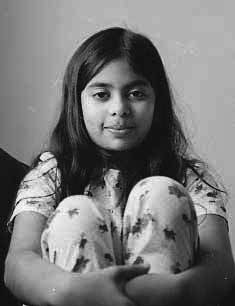
25th March 1971. My eldest niece had just been born the day before. It was a premature birth. Amma had found a Mariam flower and the flower had bloomed, heralding the birth. She had stayed behind at the clinic. We had felt something was afoot, and Babu Bhai and I went out to try and get mother and child back from Dr. Firoza Begum’s clinic in Dhanmondi. Our home might not have been safer, but at least we’d be together. Friends were building roadblocks in the streets by then, and let us through reluctantly, warning us that we had little time.
We went along the narrow road by Ramna Police station to Wireless Mor, it being too dangerous to go along the main road. I climbed over the barbed wires on the boundary walls to get to my sister’s flat, but my brother in law felt it was too dangerous to go out, so I turned back. By then the tanks were on the streets.
I had fallen asleep, but woke up to the sound of gunfire. The wide red arcs of tracer bullets had lit up the sky. The only tall building nearby was the Hotel Intercontinental, where the meetings between Mujib and Bhutto had taken place, and where the foreign journalists were staying. The slum next to the Sakura Hotel and the nearby\ newspaper office were ablaze. We could hear the screams. Those who were able to escape the fire, ran into the machine gun fire waiting outside.
Abba (my father), Babu Bhai and I watched in silence. We had argued with Abba about Pakistan, but he had been victimised as a Muslim in pre-partition India, and would not support what he saw as the break up of the nation. That night he finally broke our silence by saying, “now there is no going back.”
We heard the gunshots all night, and there was a curfew the following day. Eventually when there was a small break in the curfew the day after, Abba went to get supplies, and Babu Bhai and I got my sister and her daughter to Nasheman, in Eskaton where we lived. We called her Mukti, meaning `freedom’. But relatives warned us that it was too dangerous to use that name, even if it was a nick name to be used only amongst ourselves. So Mukti became Mowli, and even after independence, the name stuck.
Twenty five years later in 1996, I tried to put together a collection of images of ’71 for our 1996 calendar. I am reminded of the introduction:
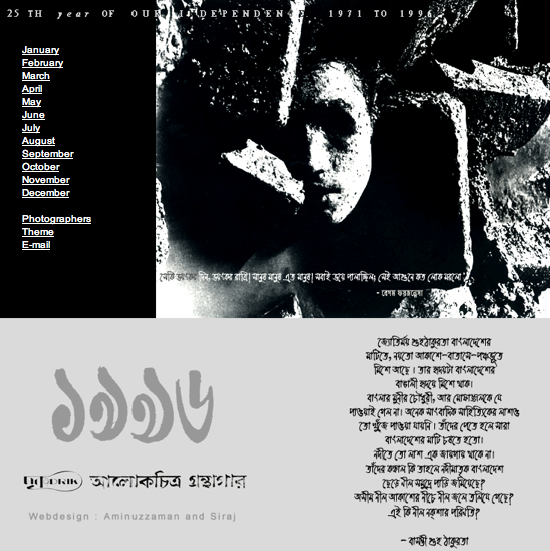
[Twenty five year ago, even longer perhaps, just a camera in hand, they had gone out to bring back a fragment of living history. Today, those photographs join them in protest. Peering through the crisp pages of the newly printed history books, they remind us, “No, that wasn’t the way it was. I know. I bear witness.”
The black and white 120 negatives, carefully wrapped in flimsy polythene, stashed away in a damp gamcha, have almost faded. The emulsion eaten away by fungus, scratched a hundred times in their tortuous journey, yellowed with age, bear little resemblance to the shiny negatives in the modern archives of big name agencies. They too are war weary, bloodied in battle.
So many have sweet talked these negatives away. The government, the intellectuals, the publishers, so many. Some never came back. No one offered a sheet of black and white paper in return. Few gave credits. The ones who risked their lives to preserve the memories of our language movement, have never been remembered in the awards given on the 21st February, language day.
25 years ago, they fought for freedom. They didn’t all carry guns, some made bread, some gave shelter, some took photographs. This is just to remind us, that this Bangladesh belongs to them all.]
Drik Calendar 1996
Today, embedded photojournalists with digital cameras, give us images of yet another aggression. This time, from the other side of the gun. The 50 clause contract that gives them access to imperial military units, like the unwritten rules that allow them access to presidential pools, ensure that `free’ media remains loyal to the warmongers. Will we ever get to see the images taken by the Iraqi photographers? Will their negatives die the same death? Will those images, like the bombed ruins of a magnificent city, be the only tattered remains of an aggression that the world allowed to happen? In ’71, the Seventh Fleet was stationed in the Bay of Bengal. The Mukti’s were not deterred by this show of power. They won us our independence. Today, after 43 more US military interventions across the globe, it is the Seventh Cavalry that bombs Iraq. And our own government, forgetting the lessons of history, forgetting that they tried to kill our unborn nation, turns against the will of its people. Our own police turn against us in our anti war rallies, to protect the biggest aggressor in history. These negatives may not survive, but the collective memory of the people of the world will, and our children will confront us in years to come.
Shahidul Alam
Dhaka
26th March 2003
* A flower from Arab deserts, used during labour to predict the time of childbirth.
** A working man’s cloth of coarse cotton, used as padding when carrying weight, to carry food, and to wipe away sweat.
The Silences We Maintain
11th September 2002. I was at Heathrow Airport, flying home to Dhaka. Friends had warned me against flying that day, but I wasn’t too bothered and looked forward to the empty seats I could stretch out on. In place of the flight notices, the loudspeakers made an unusual announcement. It was a call for a minute’s silence for the people who died at the World Trade Centre and year ago. A minute’s silence, and then it was business as usual.
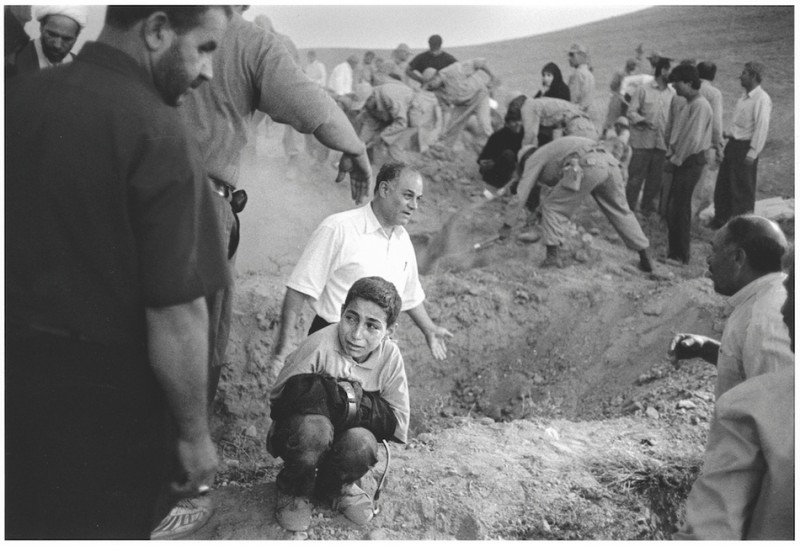
The piece that follows was written in February 2003, in the week following the judging of World Press. Before the invasion of Iraq, before the advent of embedded journalism. Later at the award ceremony at the Oude Kurk, I was impressed by Wolffensperger’s speech (Chairman of the Board, World Press Photo), made in the presence of the Dutch Prime Minister, where he clearly stated his position regarding the attack on journalists and the media coverage during the invasion. I was left wondering however, why we as a community have never called for that minute’s silence, for those killed in Afghanistan or in Iraq, or the industry’s silence on the killing of its workers. We are responsible for the words that we speak, and the images we produce. Who will take the responsibility for the silences we maintain?
——————————————————————–
Much is made of the figures, but this is not a numbers game. While the sheer volume of photographs is daunting, it is still in the end a qualitative choice. How does one weigh one photograph against another? What makes one compelling image more special than another? What criteria do juries use to determine which one is best?
The parameters for the World Press Photo of the year are known; a photograph showing outstanding visual qualities and representing a news situation of global importance. News photographs are often taken on the run, in situations of extreme stress, often in situations of danger. Only outstanding photographers are able to create powerful, moving, beautifully constructed images even under such conditions. But their qualities need to combine with outstanding news-value to create the most talked about press image of the year.
2002 was a year of waiting. Waiting for UN resolutions to be applied equally to all. Waiting for aggressors to be punished. Waiting for a war that the world abhorred but seemed unable to stop. Missing were the moments that news networks paid millions to cover. Disasters in western countries lacked significant death tolls. Nothing significant had happened in the countries that mattered.
That is not to say that nothing had happened, or that the world was at peace. In a world where all lives are not equal, some lives are easily forgotten. Their daily plight does not count. Their struggles are insignificant. No war machines come to their rescue. Unless material interests intervene.
But riots, earthquakes and indiscriminate bombings have taken place, and occupation continues. And there have been photographers who have been there. At a time when defence pools, restricted access, and editorial policy define the perimeters of journalism, some photographers have gone against the grain and covered stories which should have been news but weren’t, about people who should have mattered but didn’t.
Clinging to the trousers of his dead father, a young boy cries for a loss that is as universal as it is personal. The image talks of humankind’s eternal struggle against nature, and a community’s ability to stand by the afflicted. Yet, amidst all these people, the young man is alone in his misery. The death he mourns might not matter to a world that doesn’t care, but to him, the world might well have stopped. And one photograph preserved that moment, a silent witness of an emptiness that speaks to us all. One photographer takes on the challenge of questioning our definitions of news.
As for the judging itself, it was a complex, passionate, fervent affair. Time and time again, we were humbled by someone’s insight into a moment, that had completely passed us by. Again and again, our zone of comfort was invaded. We were shaken into responding to an argument that questioned the values that we had always considered unshakeable. Our tools of measurement were cast aside. We stood naked, our prejudices exposed.
The photographers too stretched us. Images that explored the gaps in our visual spaces, played with our sense of balance. War was presented through lingering traces. Political systems presented through emptiness and solid structures. Consumerism and decadence exposed through garish images, unashamedly rejecting the classical norms of image construction. Tender moments rendered without sentimentality. And of course those stark images, where the photojournalist, at the right place at the right time, but hopefully for not too long, returned with the horrors of what man does to man.
When the credibility of our media, shrouded in propaganda, struggles for survival, a few brave women and men continue to report the news that is no longer newsworthy. This contest salutes their courage.
Shahidul Alam
21st February. Oldham.
Chairman of the Jury 2003
A Different World
Subscribe to ShahidulNews
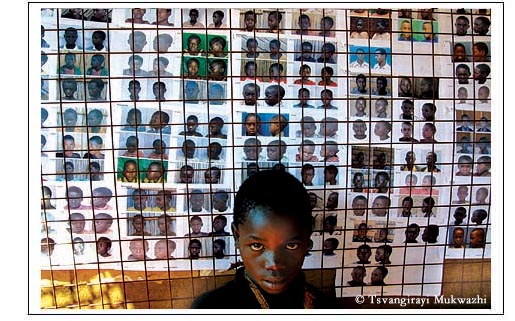
I took the picture at one of the refugee camps in Tanzania set up by the government. I was trying to show the plight of the children who were lost and never reunited with their families. It was a hot and sunny day and I was a bit tired, having visited several camps in that area. 8 year old Kindaya Chikelema from Burundi stood in front of a notice board. More than 4000 children were lost while fleeing the war in Brurundi and Rwanda. Kindaya was one of the lucky children to be found by his parents after they saw his picture on the notice board at one of the camps.
Tsvangirayi Mukwazhi
…
A Different World
…
The many letters mailed all over the world had produced few results and it was ‘door to door’ time. I had placed the loose collection of prints on Dexter Tiranti’s table at the New Internationalist Magazine in Oxford. I remember Dexter’s letter the following year, regretting that he could only use six images from our agency, as the selection already had too much from Bangladesh. That started a long relationship between our organizations and led to my involvement in Southern Exposure, a platform, like Drik, for promoting photographers from the majority world. The Net has helped, but most of our contacts have come from information gleaned on motorbike rides down the back streets of Hanoi, or a meeting in a paddy field outside Beijing, or a visit to a museum in Tehran or similar opportunities for meeting photographers, whom I would not have come across in the mainstream directories. I remember excitedly going through boxes of prints that only fellow photographers or close friends had seen. Of newly found friends telling me of people I must meet. Friends from the Drikpartnership, students, colleagues at other agencies and at World Press Photo. Friends, who like us, have believed in the plurality of image sources and have been active in trying to bring about a change.
The images too have been different. These are not the ‘developmental images’ extolling the virtue of the latest World Bank fix, or the ‘news’ images that choose not to see beyond editorial briefs. The abandon of the flutist in Bangladesh or a ‘sweet fifteen’ dance in Peru, or the careless joy of the children on the branch of a tree in South Africa represent a personal involvement of the photographer, and a relationship with the photographed, often missing in the ‘big stories’ that the major agencies send their photographers to ‘capture’. Little of what you will see here is newsworthy to mainstream media. No hype reaffirms the success of a particular development plan. It is revealing that these majority world photographers have an insight and a sensibility that is strikingly different from that of their big name visitors. It is telling that an altogether different story emerges when a different pair of eyes is behind the lens. In their own back yard, they see a different world.
..
Shahidul Alam
See Full Calendar













